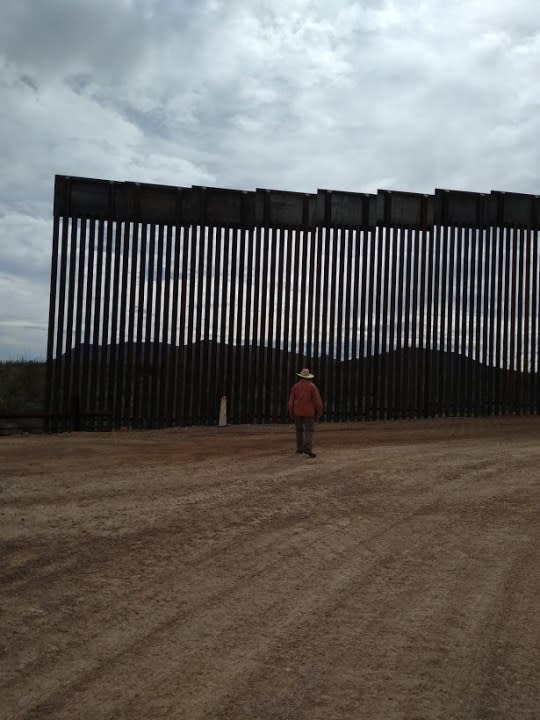GAO report outlines how border wall construction damaged environment, wildlife, cultural sites

- Oops!Something went wrong.Please try again later.
HARLINGEN, Texas (Border Report) — A federal report released Thursday found numerous instances where construction of the border wall during the Trump administration adversely impacted wildlife, the environment and Indigenous and other cultural sites on the Southwest border.
The report by the Government Accountability Office, “Southwest Border: Additional Actions Needed to Address Cultural and Natural Resource Impacts from Barrier Construction,” was prepared at the request of U.S. Rep. Raul Grijalva, D-Arizona, who is ranking member of the House Natural Resource Committee.
Judge’s ruling ordering Texas to remove border buoys from river draws praise, ire
The report was meant to analyze how and whether the 458 miles of new border barrier that was built from 2017 to January 2021 affected natural resources and wildlife and tribal and other border cultures.
Since 2017, Arizona had 223 miles of barrier panels built. That’s more than any other state, and 84% was on federal lands that suffered a destruction of habitat and erosion in places like Organ Pipe Cactus National Monument; San Bernardino National Wildlife Refuge, and Coronado National Forest, according to the 72-page report.
Sixty-six miles of border panels were built in Texas, including 11 miles in federal lands primarily in one national wildlife refuge in the Lower Rio Grande Valley.

Impeding wildlife
The report found that many miles of new border barriers replaced vehicle barriers in the desert and remote areas of Arizona. The vehicular barriers, which appeared like 3-foot-tall metal Xs — had wide gaps that allowed wildlife to cross through its base. However, the 18-foot-tall and/or 30-foot-tall metal pedestrian barriers have much narrower gaps that prevent larger wildlife from crawling through. This includes ocelots in the Rio Grande Valley of South Texas, and the Sonoran pronghorn and wolves in the West.
Water blocked
The border wall and its construction also affected water and drainage. Several water sources, like “an artesian well in the San Bernardino National Wildlife Refuge in Arizona no longer naturally flows to the surface, in part, as a result of barrier construction,” the report found. The well now requires mechanical pumps to maintain water pressure.

The barrier system also can disrupt the natural flow of water during heavy rain events and “can exacerbate flooding,” the report says.
Tribal lands
According to Tohono O’odham Nation officials, a culturally important site in Arizona was irreparably damaged when contractors used explosives to clear the way for expanding an existing patrol road leading to the border barrier. “The blasting damaged portions of Monument Hill, a site that the Hia-C’ed O’odham, ancestors of the Tohono O’odham, and other Tribes historically used for religious ceremonies and that remains important to several Indigenous communities,” the report found.
Environmentalists worry effects of border wall construction are permanent
Many saguaro cacti in Arizona, which are sacred to the Tohono O’odham Nation, were damaged during construction, the report found.
Invasive species
The clearing of land for border barrier construction also allowed invasive species to take over and “damaged native vegetation.” The report noted that many lands were “cleared without reseeding them with native vegetation.”
Light impacts
Installed lighting along the barrier also has affected bird migration and some species’ foraging habits, which can affect their ability to reproduce communicate, and compete, the GAO study found.

Solutions
When President Joe Biden took office he paused border wall construction in January 2021, but the report notes that remediation efforts also caused environmental erosion and damages, as shorter border panels were put in some places to fill in gaps.
The solution to avoiding the above problems, the report found, is for more federal agencies to better communicate construction and remediation and other border plans more thoroughly and to work more closely together.
The GAO suggests U.S. Customs and Border Protection and the Interior Department document a joint strategy to mitigate resource effects of barrier construction and that CBP evaluate lessons learned from its assessments of potential cultural and natural resource impacts. Tribal and other local leaders and stakeholders also should be consulted for lessons learned from construction effects, according to the report.
Border Patrol bridge likely to cause flooding in downtown Tijuana, study shows
Border wall opponents say the report underscored the damages suffered on the border from border wall construction.
“This report lays bare the incalculable damage border wall construction inflicted on wildlife, public lands and Indigenous nations,” Laiken Jordahl, Southwest conservation advocate at the Center for Biological Diversity, told Border Report. “These border walls haven’t done a thing to address immigration or smuggling, but they did drive endangered species closer to extinction, butcher thousands of iconic saguaro cacti and dynamite Indigenous sacred sites and burial grounds. This is a clear warning that any attempt to build additional miles of border walls would be a horrifically destructive and useless folly.”
Border Report reached out to CBP and the Department of Homeland Security and asked if the GAO solutions are agreeable with the agency. We were told that, according to the report, CBP will assign a lead coordinator to work with the Interior Department “on the creation of a joint strategy to mitigate border barrier cultural and natural resource impacts.” Going forward, tribal and local stakeholders also will be called on to collaborate on lessons learned from border barrier environmental planning efforts.
Sandra Sanchez can be reached at SSanchez@BorderReport.com.
For the latest news, weather, sports, and streaming video, head to FOX 5 San Diego.

